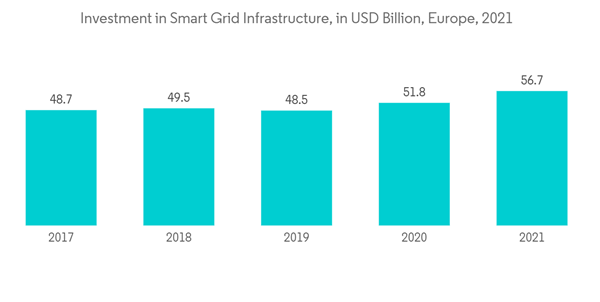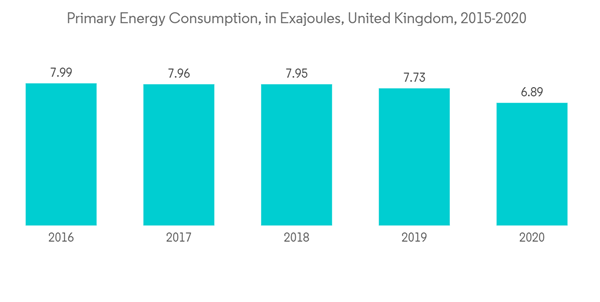Key Highlights
- Advanced metering infrastructure (AMI) is expected to witness significant growth during the forecast period due to the increasing deployment of smart grid technologies across the world's developed and emerging economies.
- Governments of both emerging and underdeveloped nations worldwide view smart grid technology as a strategic infrastructural investment that will sustain their long-term economic prosperity and help them achieve their carbon emission reduction targets. This, in turn, is expected to provide an ample amount of opportunities to the companies involved in the smart grid network market in the near future.
- The United Kingdom is expected to witness significant growth in the coming years due to large-scale investments in the market.
Key Market Trends
Advanced Metering Infrastructure (AMI) to Witness Significant Growth
- Advanced metering infrastructure (AMI) or smart metering integrates smart meters, communications networks, and data management systems that enable two-way communication between utilities and customers.
- The metering industry has taken rapid strides in the recent past few years by traversing from automated meter reading (AMR) to smart metering, using bi-directional communication, thereby enabling more significant benefits to electricity distribution companies (DISCOMs), customers, and society.
- AMI provides significant operational benefits, which leads to cost savings for utility companies and convenience for customers. AMI can significantly reduce operating costs of utility companies by remotely reading meters, connecting/disconnecting service, identifying outages, generating more accurate bills in a faster manner, and enabling utilities to provide customers digital access to their usage information.
- Furthermore, the introduction of new technologies like IoT solutions is also expected to create room for growth. For instance, in April 2021, Itron launched a new residential smart electricity meter for the German market. The company claims that it has built the new eHZ-B smart meter with advanced functionality to help German cities and utilities advance the energy transition. The smart meter is compliant with Itron’s 3. HZ FNN standard. Hence, the model is interoperable with multi-vendor environments.
- With the increasing efforts to modernize the electricity grid and reduce T&D losses, governments across Europe are investing in advanced metering infrastructure. This, in turn, is expected to drive the AMI market during the forecast period.
United Kingdom to Grow Significantly
- Public and private organizations in the United Kingdom are investing in smart electric grid upgrades, working as a driver for developed innovative products, services, or technologies related to the smart grids.
- Increasing demand, limited supply, re-emphasis on energy security, and challenging carbon emission reduction targets are driving transformation in energy utilities, and smart grid technologies will play a vital role in the coming years.
- The Uk government has committed itself to a USD 18 billion country-wide smart meter roll-out by keeping the energy suppliers responsible for the roll-out (both in terms of implementation and ownership and financing). The official smart meter roll-out began in 2016 and was initially planned to finish in 2020. However, suppliers have received an additional four years (i.e., till 2024) to keep installing meters. The roll-out start date was pushed back several times, and there have been delays with many parts of the roll-out since.
- Furthermore, on the innovation front, in 2021, Northern Powergrid started its pilot smart grid network technology to increase the resilience of ‘the micro-regions' of the grid. The UKP 2.5 million program named Microresilience uses energy storage systems (ESS) and innovative communications technology to maintain power supplies to vital infrastructure and remote communities. New innovations are expected to make the technology more accessible in different parts of the world.
- The most important trend to ascertain the growth of the smart grid is the rising demand for energy in the country, which has seen some setbacks due to COVID-19, but it is expected to grow significantly in 2021. In 2020, the primary energy consumption of the United Kingdom was around 6.89 Exajoules, which was a decrease from 7.73 Exajoules in 2019.
- Hence, the UK smart grid market is expected to grow during the forecast period due to increasing investments, government policies, and innovative projects.
Competitive Landscape
The European smart grid network market is fragmented. Some of the major companies include Électricité de France SA, E.ON SE, SSE PLC, Schneider Electric SE, and Renault Group.
Additional Benefits:
- The market estimate (ME) sheet in Excel format
- 3 months of analyst support
This product will be delivered within 2 business days.
Table of Contents
Companies Mentioned (Partial List)
A selection of companies mentioned in this report includes, but is not limited to:
- Electricite de France SA
- E.ON SE
- Schneider Electric SE
- Renault Group
- Siemens AG
- Efacec Energia
- Landis+Gyr Group AG
- Hitachi Ltd
- General Electric Company










